Adjust image quality settings.
To display image quality settings, press [MENU]/[OK] in the shooting display and select the ([IMAGE QUALITY SETTING]) tab.
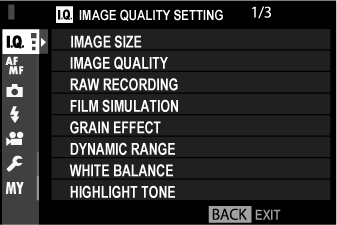
The options available vary with the shooting mode selected.
Choose the size and aspect ratio at which still pictures are recorded.
| Option | Image size |
|---|---|
| 6000 × 4000 | |
| 4240 × 2832 | |
| 3008 × 2000 |
| Option | Image size |
|---|---|
| 6000 × 3376 | |
| 4240 × 2384 | |
| 3008 × 1688 |
| Option | Image size |
|---|---|
| 4000 × 4000 | |
| 2832 × 2832 | |
| 2000 × 2000 |
[IMAGE SIZE] is not reset when the camera is turned off or another shooting mode is selected.
Aspect Ratio
Pictures with an aspect ratio of 3:2 have the same proportions as a frame of 35 mm film, while an aspect ratio of 16:9 is suited to display on High Definition (HD) devices. Pictures with an aspect ratio of 1:1 are square.
Choose a file format and compression ratio. Select [FINE] or [NORMAL] to record [JPEG] images, [RAW] to record RAW images, or [FINE+RAW] or [NORMAL+RAW] to record both JPEG and RAW images. [FINE] and [FINE+RAW] use lower JPEG compression ratios for higher-quality JPEG images, while [NORMAL] and [NORMAL+RAW] use higher JPEG compression ratios to increase the number of images that can be stored.
The Function Buttons
To toggle RAW image quality on or off for a single shot, assign [RAW] to a function button (Assigning Roles to the Function Buttons). If a JPEG option is currently selected for image quality, pressing the button temporarily selects the equivalent JPEG+RAW option. If a JPEG+RAW option is currently selected, pressing the button temporarily selects the equivalent JPEG option, while if [RAW] is selected, pressing the button temporarily selects [FINE]. Taking a picture or pressing the button again restores the previous setting.
Choose whether to compress RAW images.
| Option | Description |
|---|---|
| [UNCOMPRESSED] | RAW images are not compressed. |
| [LOSSLESS COMPRESSED] | RAW images are compressed using a reversible algorithm that reduces file size with no loss of image data. The images can be viewed in [RAW FILE CONVERTER EX 2.0] or other software that supports “lossless” RAW compression. |
Simulate the effects of different kinds of film, including black-and-white (with or without color filters). Choose a palette according to your subject and creative intent.
| Option | Description |
|---|---|
[PROVIA/STANDARD] |
Standard color reproduction. Suited to a wide range of subjects, from portraits to landscapes. |
[Velvia/VIVID] |
A high-contrast palette of saturated colors, suited to nature photos. |
[ASTIA/SOFT] |
Enhances the range of hues available for skin tones in portraits while preserving the bright blues of daylight skies. Recommended for outdoor portrait photography. |
[CLASSIC CHROME] |
Soft color and enhanced shadow contrast for a calm look. |
[PRO Neg. Hi] |
Offers slightly more contrast than |
[PRO Neg. Std] |
A soft-toned palette. The range of hues available for skin tones is enhanced, making this a good choice for studio portrait photography. |
[ACROS] * |
Take black-and-white photos with rich gradation and outstanding sharpness. |
[MONOCHROME] * |
Take pictures in standard black and white. |
[SEPIA] |
Take pictures in sepia. |
* Available with yellow ([Ye]), red ([R]), and green ([G]) filters, which deepen shades of gray corresponding to hues complementary to the selected color. The yellow ([Ye]) filter deepens purples and blues and the red ([R]) filter blues and greens. The green ([G]) filter deepens reds and browns, including skin tones, making it a good choice for portraits.
Film simulation options can be combined with tone and sharpness settings.
Film simulation settings can also be accessed via shortcuts (Shortcut Options).
For more information, visit: “The World of Film Simulation episode 1”
Add a film grain effect. Select an amount ([STRONG] or [WEAK]) or choose [OFF] to turn film grain off.
| Options | ||
|---|---|---|
| [STRONG] | [WEAK] | [OFF] |
Control contrast. Choose lower values to increase contrast when shooting indoors or under overcast skies, higher values to reduce loss of detail in highlights and shadows when photographing high-contrast scenes. Higher values are recommended for scenes that include both sunlight and deep shade, for such high-contrast subjects as sunlight on water, brightly-lit autumn leaves, and portraits taken against a blue sky, and for white objects or people wearing white; note, however, that mottling may appear in pictures taken at higher values.
| Options | |||
|---|---|---|---|
| [AUTO] | |||
If [AUTO] is selected, the camera will automatically choose either [100%] or
[200%] according to the subject and shooting conditions. Shutter speed and aperture will be displayed when the shutter button is pressed halfway.
[200%] is available at sensitivities of ISO 400 and above,
[400%] at sensitivities of ISO 800 and above.
For natural colors, choose a white balance option that matches the light source.
| Option | Description |
|---|---|
| [AUTO] | White balance is adjusted automatically. |
| Measure a value for white balance. | |
| Choose a color temperature. | |
| For subjects in direct sunlight. | |
| For subjects in the shade. | |
| Use under “daylight” fluorescent lights. | |
| Use under “warm white” fluorescent lights. | |
| Use under “cool white” fluorescent lights. | |
| Use under incandescent lighting. | |
| Reduces the blue cast typically associated with underwater lighting. |
Results vary with shooting conditions. Play pictures back after shooting to check colors.
White balance is adjusted for flash lighting only in [AUTO] and modes. Turn the flash off using other white balance options.
White balance options can also be accessed via shortcuts (Shortcut Options).
Pressing [MENU]/[OK] after selecting a white balance option displays the dialog shown at right; use the selector to fine-tune white balance or press [DISP]/[BACK] to exit without fine-tuning.

Choose ,
, or
to adjust white balance for unusual lighting conditions. White balance measurement options will be displayed; frame a white object so that it fills the display and press the shutter button all the way down to measure white balance (to select the most recent custom value and exit without measuring white balance, press [DISP]/[BACK], or press [MENU]/[OK] to select the most recent value and display the fine-tuning dialog).
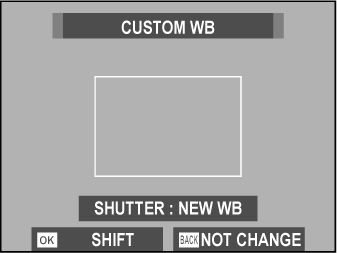
If “[COMPLETED!]” is displayed, press [MENU]/[OK] to set white balance to the measured value.
If “[UNDER]” is displayed, raise exposure compensation and try again.
If “[OVER]” is displayed, lower exposure compensation and try again.
Selecting in the white balance menu displays a list of color temperatures; highlight a color temperature and press [MENU]/[OK] to select the highlighted option and display the fine-tuning dialog.
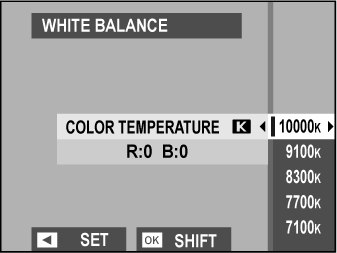
Color Temperature
Color temperature is an objective measure of the color of a light source, expressed in Kelvin (K). Light sources with a color temperature close to that of direct sunlight appear white; light sources with a lower color temperature have a yellow or red cast, while those with a higher color temperature are tinged with blue. You can match color temperature to the light source, or choose options that differ sharply from the color of the light source to make pictures “warmer” or “colder.”
Adjust the appearance of highlights. Choose from seven options between +4 and −2.
| Options | ||||||
|---|---|---|---|---|---|---|
| [+4] | [+3] | [+2] | [+1] | [0] | [−1] | [−2] |
Adjust the appearance of shadows. Choose from seven options between +4 and −2.
| Options | ||||||
|---|---|---|---|---|---|---|
| [+4] | [+3] | [+2] | [+1] | [0] | [−1] | [−2] |
Adjust color density. Choose from nine options between +4 and −4.
| Options | ||||||||
|---|---|---|---|---|---|---|---|---|
| [+4] | [+3] | [+2] | [+1] | [0] | [−1] | [−2] | [−3] | [−4] |
Sharpen or soften outlines. Choose from nine options between +4 and −4.
| Options | ||||||||
|---|---|---|---|---|---|---|---|---|
| [+4] | [+3] | [+2] | [+1] | [0] | [−1] | [−2] | [−3] | [−4] |
Reduce noise in pictures taken at high sensitivities. Choose from nine options between +4 and −4.
| Options | ||||||||
|---|---|---|---|---|---|---|---|---|
| [+4] | [+3] | [+2] | [+1] | [0] | [−1] | [−2] | [−3] | [−4] |
Select [ON] to reduce mottling in long time-exposures.
| Options | |
|---|---|
| [ON] | [OFF] |
Select [ON] to improve definition by adjusting for diffraction and the slight loss of focus at the periphery of the lens.
| Options | |
|---|---|
| [ON] | [OFF] |
Choose the gamut of colors available for color reproduction.
| Option | Description |
|---|---|
| [sRGB] | Recommended in most situations. |
| [Adobe RGB] | For commercial printing. |
Use this option if you notice bright spots in your pictures.
Press [MENU]/[OK] in the shooting display and select the [IMAGE QUALITY SETTING] tab.
Highlight [PIXEL MAPPING] and press [MENU]/[OK] to perform pixel mapping. Processing may take a few seconds.
Results are not guaranteed.
Be sure the battery is fully charged before beginning pixel mapping.
Pixel mapping is not available when the camera temperature is elevated.
Recall settings saved with [EDIT/SAVE CUSTOM SETTING]. Settings can be recalled from any of the seven custom settings banks.
| Banks | |||||||||||
|---|---|---|---|---|---|---|---|---|---|---|---|
| [CUSTOM 1] | [CUSTOM 2] | [CUSTOM 3] | [CUSTOM 4] | ||||||||
| [CUSTOM 5] | [CUSTOM 6] | [CUSTOM 7] | |||||||||
Save up to 7 sets of custom camera settings for commonly-encountered situations. Saved settings can be recalled using [IMAGE QUALITY SETTING] > [SELECT CUSTOM SETTING].
Press [MENU]/[OK] in shooting mode to display the shooting menu. Select the [IMAGE QUALITY SETTING] tab, then highlight [EDIT/SAVE CUSTOM SETTING] and press [MENU]/[OK].
Highlight a custom settings bank and press [MENU]/[OK] to select.
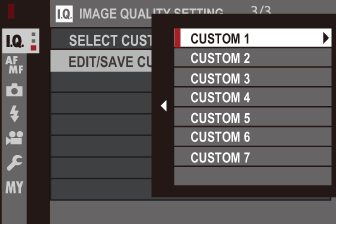
Adjust the following as desired:
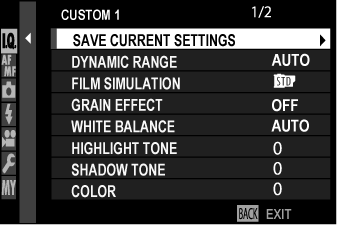
Press [DISP]/[BACK]. A confirmation dialog will be displayed; highlight [OK] and press [MENU]/[OK].
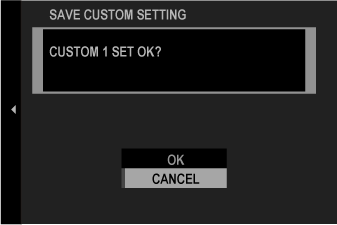
To store current camera settings in the selected bank, highlight [SAVE CURRENT SETTINGS] in Step 3 and press [MENU]/[OK]. Banks can be renamed using [EDIT CUSTOM NAME].
To restore default settings for the current bank, select [RESET].